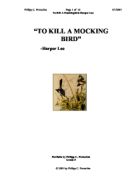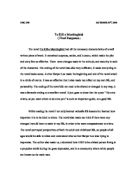Write about the ways that Lee shows the significance of the title in ‘To Kill A Mockingbird’
In part one of ‘To Kill A Mockingbird’ (Mockingbird) Atticus tells Jem and Scout that “it’s a sin to kill a mockingbird.” The word “sin” suggests that it’s a crime against God and alerts the reader to the importance of what Atticus is saying. It is Miss Maudie’s further explanation, however, which enables us to link the mockingbird motif to 2 characters in the novel. According to Miss Maudie, mockingbirds “don’t do one thing but sing their hearts out for us.” They simply make beautiful music for people to enjoy. They are innocent of wrongdoing (such as eating “up people’s gardens”). Reading on through the novel, it therefore becomes obvious that the mockingbird is used asan analogy for Tom Robinson and for Boo Radley.
Tom Robinson is a victim of racial prejudice; he ends up in court, fighting for his life, because he is accused of rape by Mayella Ewell. Twice during the court case, Lee makes it very specific that he is like a mockingbird. During his testimony, we hear about how often Tom Robinson tried to help Mayella with her chores. When asked why he was “so anxious to do that woman’s chores”, Tom replies, “Looked like she didn’t have nobody to help her”. Tom feels compassion for Mayella, he realises that she gets no help from her father or from the children. Like a mockingbird, therefore, he tries to make life more pleasant for her. Tragically, this eventually leads to his death. He makes a major mistake in court when he says that he helped Mayella because he “felt right sorry for her, she seemed to try more’n the rest of ‘em –“. The dash here shows how quickly Mr Gilmer interrupts, in order to alert the jury to the impudence of Tom’s reply. He responds with “You felt sorry for her, you felt sorry for her?” You, sorry and her are printed in italics to show that Mr Gilmer wants the jury to be outraged. He also uses simple clauses to get his message home. And succeeds. Lee writes “Below us, nobody liked Tom Robinson’s answer.” “Nobody” is used to show that the jury and the onlookers are united and horrified by Tom daring to feel sorry for a white woman.







